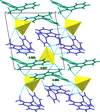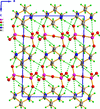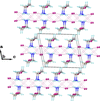issue contents
November 2024 issue

Cover illustration: The crystal structure of an elusive Ni(cyclen) nitrate, namely (nitrato-κ2O,O′)(1,4,7,10-tetraazacyclododecane-κ4N)nickel(II) nitrate is twinned by a twofold rotation about its a axis. It was determined as part of a student workshop at Prairie View A&M and Texas A&M Universities. See: Reibenspies, Small, Bhuvanesh, Chiarella, Salazar, Pery, Smith, Toole, Hewage, Fernando & Reinheimer [Acta Cryst. (2024). E80, 1061–1064].
research communications
Download citation


Download citation


The crystal structures of two 1H-indole derivatives are described and the analysis of the intermolecular contacts in the crystals using Hirshfeld surface analysis and two-dimensional fingerprint plots is reported.
Download citation


Download citation


The title molecule adopts a cup-shaped conformation with the distinctly ruffled imidazolidine ring as the base. In the crystal, weak C—H⋯O hydrogen bonds and C—H⋯π(ring) interactions form helical chains of molecules extending along the b-axis direction, which are linked by additional weak C—H⋯π(ring) interactions across inversion centres.
CCDC reference: 2385417
Download citation


Download citation


The photoluminescent properties of the monoclinic and triclinic polymorphs in the solid state are strictly comparable, presumably because the spatial organization of both polymorphs is quite similar.
CCDC reference: 2388010
Download citation


Download citation


Modulation of the phenyl groups in N,N′-dibenzylethylenediammonium dichloride in P21/n allows for the formation of a network of strong N—H⋯Cl hydrogen bonds and C—H⋯Cl interactions and breaks C2/c symmetry.
CCDC reference: 2387167
Download citation


Download citation


4-Nitrophenol and 4,4′-bipyridine crystallized together in a 2:1 ratio and in the space group P21/n. There is a hydrogen-bonding interaction between the nitrogen atoms on the 4,4′-bipyridine molecule and the hydrogen atom on the hydroxyl group on the 4-nitrophenol resulting in trimolecular units.
CCDC reference: 2388458
Download citation


Download citation


In the title compound, the dianionic [CH3O(CH2)3P(=S)(S—)CH2CH2P(=S)(S—)(CH2)3OCH3]2− ligand fragments are joined by a dicationic [Na2(H2O)8]2+ cluster that includes the oxygen of the methoxypropyl unit of the ligand to form infinite chains.
CCDC reference: 2388007
Download citation


Download citation


The crystal structure of a mercury(II) halide complex containing bis(tert-butylamido)cyclodiphosphazane ligand with an unusual chelation mode is reported. The molecular structure features weak N—H⋯O interactions that propagate and link the molecules into a three-dimensional structure.
CCDC reference: 2386028
Download citation


Download citation


Two different multi-component crystals consisting of papaverine [1-(3,4-dimethoxybenzyl)-6,7-dimethoxyisoquinoline, C20H21NO4] and fumaric acid [C4H4O4] were obtained.
Download citation


Download citation


In the title compound, the [SbS4]3– anions bridge two Zn(cyclam)2+ cations into [Zn2(cyclam)2SbS4]+ cations, which are charged-balanced by perchlorate anions. The components are linked by N—H⋯O, N—H⋯S and O—H⋯S hydrogen bonds into a three-dimensional network.
CCDC reference: 2385974
Download citation


Download citation


The crystal structure of [(1,4,7,10-tetraazacyclododecane)(nitrate)]nickel(II) nitrate, at room temperature, has monoclinic (P21/n) symmetry. The structure displays intermolecular hydrogen bonding.
CCDC reference: 2386999
Download citation


Download citation


1H-1,2,4-Triazole-3,5-diamine monohydrate was synthesized and its crystal structure was determined. Two 3,5-diamino-1,2,4-triazole molecules form mutual hydrogen bonds.
CCDC reference: 2251960
Download citation


Download citation


The crystal structure of the title compound was solved to confirm the relative absolute configuration of the chiral centers.
CCDC reference: 2389407
Download citation


Download citation


The crystal structures of 2-hydroxy-N′-methylacetohydrazide and 2-hydroxy-N-methylacetohydrazide are reported and discussed.
Download citation


Download citation


The title compound is a dinuclear zinc(II) complex with three chlorido ligands and one pentadentate ligand containing quinolin-8-olato and bis(pyridin-2-ylmethyl)amine units. One ZnII atom has a tetrahedral coordination environment by two chlorido and chelate coordination of the N and O atoms of the quinolin-8-olato unit in the pentadentate ligand, and the other has a distorted trigonal–bipyramidal coordination environment by one chlorido and four donating atoms except for the N atom of the quinolin-8-olato in the pentadentate ligand. In the crystal, the molecules are linked by four different kinds of intermolecular C—H⋯Cl hydrogen bonds, forming a three-dimensional network structure.
CCDC reference: 2389039
Download citation


Download citation


The crystal structure of the title compound is consolidated by C—H⋯O, C—H⋯π and π–π stacking interactions. Hirshfeld surface analysis indicates that dispersion energy makes a dominate contribution to the isosurface.
CCDC reference: 2391127
Download citation


Download citation


The title compound was synthesized from acetylacetone and benzimidazole derivative. There are two independent complex molecules in the asymmetric unit, which are linked by N—H⋯O and O—H⋯O hydrogen bonds along [111].
CCDC reference: 2383609
Download citation


Download citation


A new crystal structure of [Ni(OH2)6]Cl2·(18-crown-6)2·2H2O is reported, demonstrating the effect a small chloride counter-ion has on the hydrogen-bonding network.
CCDC reference: 2391132
Download citation


Download citation


In the crystal structure, the molecules are connected by N—H⋯O hydrogen bonds to create two-dimensional supramolecular networks extending parallel to the crystallographic ab plane.
CCDC reference: 2389250
Download citation


Download citation


The title molecule adopts a conformation in which the three phenyl rings are arranged in a paddlewheel-like fashion around the central arene ring and the carboxyl residue is oriented nearly perpendicular to the plane of this benzene ring. Inversion-symmetric dimers of O—H⋯O-bonded molecules represent the basic supramolecular entities of the crystal structure. These dimeric molecular units are further linked by C—H⋯O=C bonds, forming one-dimensional supramolecular aggregates along [111].
CCDC reference: 2391130
Download citation


Download citation


In the title salt, the complete cation and anion are generated by crystallographic inversion and twofold symmetry, respectively. In the crystal, the dihydrogen diphosphate anions are linked by O—H⋯O hydrogen bonds, generating (001) layers. The organic cations bond to the inorganic layers by way of N—H⋯O and C—H⋯O hydrogen bonds.
CCDC reference: 2386600
Download citation


Download citation


The multi-component solvated Lopinavir crystal was prepared using evaporative methods. The crystal structure is unusual in that the unit cell contains 18 molecules. The stoichiometric ratio of this crystal is eight Lopinavir molecules, three ethane-1,2-diol molecules and seven water molecules.
CCDC reference: 2306134
Download citation


Download citation


Two new zinc(II) complexes, C21H13Cl2N2O3Zn·C6H16N (ZnOQ) and C20H14Cl4N2O2Zn·2C6H16N (ZnBS), were synthesized and their structures were determined using ESI–MS spectrometry, 1H NMR spectroscopy, and single-crystal X-ray diffraction.
Download citation


Download citation


In [Co(Br4bdc)(im)2(H2O)2], the CoII ions are bridged by the Br4bdc2− ligand, forming one-dimensional chains, which are interconnected by interchain N–H⋯O and O–H⋯O hydrogen-bonding and π–π interactions, yielding a three-dimensional network.
CCDC reference: 2391124
Download citation


Download citation


The phenylacetamide moiety is nearly planar due to a weak, intramolecular C—H⋯O hydrogen bond and its nitrogen lone pair appears involved in N→C π bonding. In the crystal, N—H⋯O hydrogen bonds and π-stacking interactions between pyridazine and phenyl rings form helical chains of molecules, which are linked by C—H⋯O hydrogen bonds and C—H⋯π(ring) interactions.
CCDC reference: 2392686
Download citation


Download citation


The organic 2-iodoethylammonium cation forms N—H⋯I hydrogen bonds with iodide anions, forming supramolecular layers.
CCDC reference: 2393092
Download citation


Download citation


Compound 1 is the anhydrous form of the known crystal 2-amino-5-iodopyridinium bromide monohydrate and crystallizes in layers inclined ∼40° to the ab face. Hydrogen bonding between the amino and pyridinium ions to the bromide ion acceptor stabilizes the layers. Compound 2 is a salt of 2-amino-5-iodopyridium and a trihalidocobaltate(II) ion with one coordinated 2-amino-5-iodopyridine ligand. The halide ions are mixed Cl/Br with differing occupancies.
Download citation


Download citation


The title compound, a neutral bis{5-(4-chlorophenyl)-3-[6-(1H-pyrazol-1-yl)pyridin-2-yl]-1H-1,2,4-triazol-1-ido}nickel(II) methanol disolvate has a distorted pseudooctahedral coordination environment of the metal ion. As a result of the tapered shape and polar nature, the molecules stack in one-dimensional columns that are bound by weak hydrogen bonds into layers, which are arranged in a three-dimensional structure without interlayer interactions below van der Waals radii.
CCDC reference: 2393088
Download citation


Download citation


The tripodal title molecule exists in a conformation in which the substituents attached to the central arene ring are arranged in an alternating order above and below the ring plane. In the crystal, only weak molecular cross-linking involving C—H⋯N hydrogen bonds is observed.
CCDC reference: 2391226

 journal menu
journal menu
















































